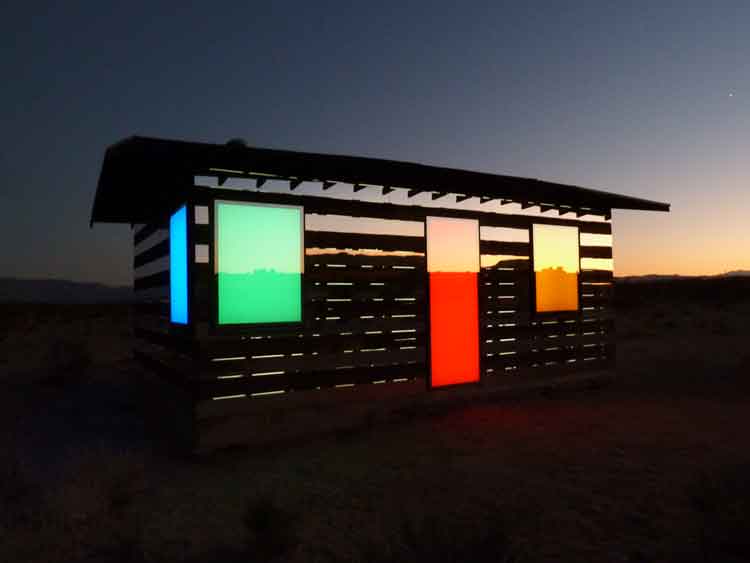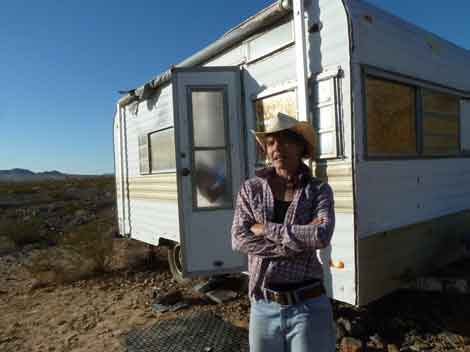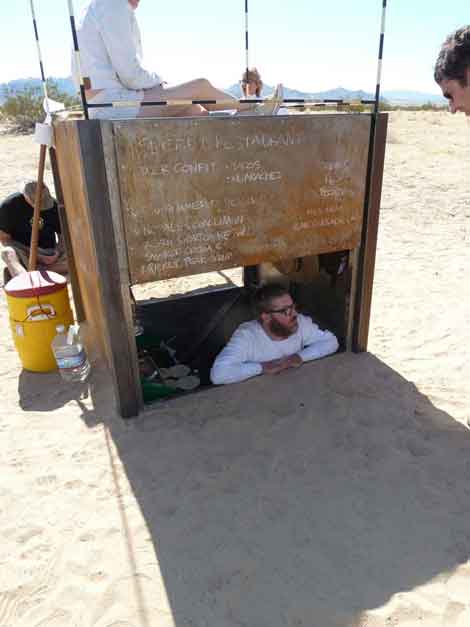I didn’t know what to expect on my first visit to High Desert Test Sites, a series of art installations and performances out in the desert organized by artist Andrea Zittel, Aurora Tang and their team. The most ambitious edition yet, HDTS 2013 featured some 60 projects, stretching from Joshua Tree to Albuquerque over a week, Oct. 12–19. Their mission has been to support “experimental art that engages with the local environment and community.” Before going, I knew that the best work would make use of the dry, sere landscape of elemental sparseness, and of the light which one becomes so present in that pared-down environment. I wasn’t disappointed.
Given temporal and monetary limitations, I checked out as many sites as possible during opening weekend in Joshua Tree and vicinity. The small official guide map was pretty rudimentary, and I gather that getting lost is part of the HDTS adventure. I found the sites mainly by a) going with someone who knew the lay of the land and b) talking to other seekers along the way. The first time I came to Debbie Long’s very worthwhile detour off the main road, “Naima,” I was led by someone who had worked on the project; the second time by signs that were put up. What was an old trailer from the outside held a gem inside—a chamber encrusted with pinkish cast glass “growths.” These pieces had been carefully fitted into custom cutouts so that the light from the outside (the top of the trailer was open) was filtering through them, and bean bags were provided for visitors to lie back on. I was reminded of stalactite caverns, except these protrusions glowed from within and bathed you in their transmission.
Two of the most remarkable pieces were suggested by people I ran into. At Saturday night’s opening dinner at The Palms—itself a wonderfully hip-funky restaurant and saloon on Amboy Road and the site of several art pieces—I ran into Asuka Hisa of the Santa Monica Museum of Art. She had spent the day scouring the desert and gave me this recommendation: “Secret Restaurant.” Later that evening I met artist Bob Dornberger while walking to “We Build Excitement” by Jesse Sugarman, a kind of post-apocalyptic car dealer with eerily glowing Pontiac signs. Two cars were stuck in the sand in a V shape, held up by steel poles, and another perched on its own stand like a giant piece of cake. All this around an abandoned shack. Quite cool.
The Secret Restaurant was 20 minutes away, plus a trek through the desert, so the next day my friends and I drove out there for lunch. Out in the middle of nowhere rose a steel booth largely buried into the sand. In his white chef’s jacket Dornberger stood inside cooking up tacos and quesadillas at his miniature kitchen—he took orders from “windows” on two sides, so we had to stoop down to talk and look at him. On top of the booth was a small “sunroof” where you were welcome to sit—if you could fit. “The idea came from a proposal I once made for a seasonal restaurant—it would be open only four days a year,” he told me. “Needless to say, it didn’t fly.” So he thought this up: a restaurant in the middle of the desert that was only operational three days. That said, word of mouth was such that there was a steady stream of people making the jaunt there for Sunday lunch.
The other remarkable recommendation was a non-HDTS piece, although the HDTS center helped distribute the postcard which helped me find it. At a health food cafe Sunday morning, a local artist showed me photos of Philip K. Smith III’s “Lucid Stead” on her smart phone. Later I contacted Rick Royale, Smith’s rep, and went on Monday, up Sunburst Street and onto a long stretch of dirt road which seemed never to end. From a meeting point, my friends and I were taken by Phil and Rick to the site—and we came upon a lone homestead shack in dark weathered wood amidst an expanse of packed sand and shrub.
As we got closer, we could see that Smith had taken out alternating slats and replaced them with mirrored plastic slats, so that the desert—and we—were reflected in horizontal strips. It was simply stunning. So stunning I returned at sunset for the night illumination of the shack. As dusk came, Smith turned on the inside lights—which showed up the cracks and inside diagonal supports in white light, while, quite magically, the windows and door became solid panes of slowly shifting color. (Okay, done through LEDs.) That piece alone was worth the drive and the dust and the possible damage to my aging car shocks. Although no future viewings of “Lucid Stead” are scheduled, Smith is having a show at Royale Projects in Palm Desert opening Nov. 29—check www.royaleprojects.com/
A couple other notables from the weekend were the wildly incongruent crocheted pup tents set midst boulders by Lea Donnan in “Desert Applique” and the awe-inspiring sound and light show put on by Pascual Sisto and Joey Jensen on Sunday night at the Big Boulder.
Maybe next year I’ll get to Albuquerque.
All photos by Scarlet Cheng





















0 Comments